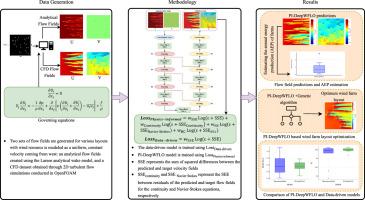风电场流场预测的物理信息深度卷积分层编码器-解码器神经网络
IF 9.6
Q1 COMPUTER SCIENCE, ARTIFICIAL INTELLIGENCE
引用次数: 0
摘要
风电场布局优化(WFLO)是风电场设计的关键步骤,其重点是确定风电场的最佳布局,以使风电场的年发电量(AEP)最大化。在WFLO中,计算AEP作为目标函数通常依赖于计算成本高昂的计算流体动力学(CFD)模拟来计算农场内的流场。在这项研究中,我们提出PI-DeepWFLO,一个物理信息的深度卷积分层编码器-解码器神经网络,作为替代模型来预测各种涡轮配置的流场,大大减少了对昂贵的CFD模拟的依赖。PI-DeepWFLO使用包含质量和动量守恒定律的定制物理损失函数对标记数据进行训练。结果表明,所提出的PI-DeepWFLO能够准确预测展向和流向速度场(R2=0.955),有效捕获涡轮之间的尾迹相互作用。此外,研究结果表明,PI-DeepWFLO对网络权重初始化和训练数据集的变化不太敏感,与纯数据驱动的替代方法相比,在训练数据集的不同重新采样上,R2方差降低了10倍。PI-DeepWFLO计算的AEP值与cfd生成的流场的比较表明,测试用例的中位误差为1.25%。重要的是,CFD计算的AEP与PI-DeepWFLO流场的AEP之间的Spearman’s Rank相关系数为1.0,证实了PI-DeepWFLO在优化研究中对AEP估计的适用性。我们通过使用PI-DeepWFLO作为WFLO任务的代理模型来说明它在应用程序上下文中的性能。本文章由计算机程序翻译,如有差异,请以英文原文为准。

Physics-informed deep convolutional hierarchical encoder-decoder neural network for flow field prediction in wind farms
Wind Farm Layout Optimization (WFLO) is a critical step in wind farm design, focusing on determining the optimal placement of turbines to maximize the annual energy production (AEP) of wind farms. Calculating AEP as an objective function in WFLO often relies on computationally expensive computational fluid dynamics (CFD) simulations to calculate the flow field within the farm. In this study, we propose PI-DeepWFLO, a physics-informed deep convolutional hierarchical encoder-decoder neural network, as a surrogate model to predict flow fields for various turbine configurations, significantly reducing dependence on costly CFD simulations. PI-DeepWFLO is trained on labeled data using a customized physics-informed loss function that incorporates mass and momentum conservation laws. Our results show that the proposed PI-DeepWFLO accurately predicts spanwise and streamwise velocity fields (), effectively capturing wake interactions between turbines. Furthermore, results show that PI-DeepWFLO is less sensitive to variations in network weight initialization and training datasets than purely data-driven alternatives, exhibiting a ten-fold lower variance over different re-samplings of the training dataset. A comparison of AEP values calculated from PI-DeepWFLO and CFD-generated flow fields demonstrates a median error of 1.25 % across test cases. Importantly, the Spearman’s Rank Correlation Coefficient between AEPs from CFD and PI-DeepWFLO flow fields is 1.0, confirming the PI-DeepWFLO’s suitability for AEP estimation in optimization studies. We illustrate PI-DeepWFLO’s performance in an application context by employing it as a surrogate model for a WFLO task.
求助全文
通过发布文献求助,成功后即可免费获取论文全文。
去求助
来源期刊

Energy and AI
Engineering-Engineering (miscellaneous)
CiteScore
16.50
自引率
0.00%
发文量
64
审稿时长
56 days
 求助内容:
求助内容: 应助结果提醒方式:
应助结果提醒方式:


